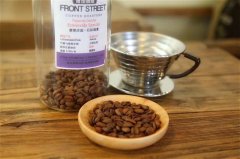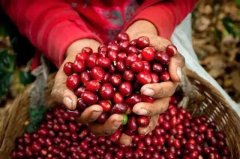Introduction to the origin of coffee in Colombia, coffee varieties, three major producing areas and harvest season
Professional coffee knowledge exchange more coffee bean information please follow the coffee workshop (Wechat official account cafe_style)
Origin
Colombia is the world's third largest exporter of coffee, mainly producing Arabica coffee and the largest exporter of Arabica beans. In 1808, a priest introduced coffee to Colombia for the first time from the French Antilles via Venezuela. Today, the country is the second largest coffee producer after Brazil, the world's largest exporter of Arabica coffee beans and the world's largest exporter of washed coffee beans. Colombian coffee is often described as silky and smooth. Of all the coffees, it is the most balanced, soft, smooth and ready to drink, and it has won praise that no other coffee can match: known as "green gold".
Production season in producing area
The latitude span of the Colombian producing area and the topographic influence of the Andes are divided into three regions from south to north, northern, central, and southern; the northern part of the south has a distinct production season, and the central part has two primary and secondary seasons according to the north or the south, respectively. there are two harvest seasons in a year, the main season is from October to January, and the secondary season is from April to July.
Harvest season [by region]
Due to the differences in geographical and climatic characteristics from north to south, the north-south production season is just opposite, while the central part has its own primary and secondary production seasons according to whether it is south or north. It can be said that beans are produced all the year round. Here we mainly divide the trough region according to the winter season and summer season.
The winter season is from September to December, including the following areas
Magdalena Magdalena common items
Santander Santander
Antioquia Andi O'Quia common items
North of Santander North of Santander
Boyaca Boyaca
Meta Matta
The central region near the north will have two primary and secondary seasons, the main season is from September to December in winter, and the secondary season is between April and May in summer.
Caldas Caldas
Risaralada Salala da
Cundinamarca Quintina Maka's partial slotting domain began to emerge in the market.
The partial slotting domain of Quinido Jindio began to emerge in the market.
Tolima Torima partial slotted domain secondary ash grade common items
The central region near the south will have two primary and secondary seasons, the main season is from March to June in summer, and the secondary season is from October to November in winter.
Valle Wayer division slot domain began to come to the fore in the market
Quindio Kingdeo partial slotted domain
Cundinamarca Quintina Maka partial slotting domain
Tolima Tolima partial slotted domain
The summer production season is from March to June, including the following areas
Valle Wayer division slot domain
The bone ash grade of Cauca test is common.
Cundinamarca Quintina Maka partial slotting domain
Huila Huilan ashes are common
Narino Na Linglong secondary bone ash grade is common
Note: the production season here refers to the stage of post-processing when the coffee fruit is ripe and harvested in the producing area. Usually 2-3 months after this stage, the beans of the real new production season will arrive at our consumption end.

Coffee variety
In addition to the common coffee varieties in the Americas, such as Kaddura Caturra, Bourbon Bourbon, Tippika Typica and Parkmara, Colombia also has its own three disease-resistant varieties, namely Castillo Castillo and Tabi Tabi Colombian Colombia with the same name as the country. Of course, there are also some rare and valuable varieties such as Rosa Gesha, small-grained Mocha Mocca, Rume Sudan Romer Sultan, Eugenioides Eugene Odes, Laurina pointed Bourbon, Maraguesa Mara Rosa (a natural hybrid between Marago Rippi and Rosa).
The early varieties planted in Colombia were the old iron pickup and bourbon, which were replaced by Kaddura in 1970; Kaddura is not only more productive per plant than iron pickup and bourbon, but also can be planted more per unit of acreage because the tree is more compact.
Since 1961, CENICAFE began to study Timor varieties of Robusta blood, and then selected Timor and Caturra into Columbia's Katim Catimor series. After five generations of breeding, CENICAFE released Colombia's first disease-resistant variety Colombia in 1982, and then after the emergence of leaf rust in 1983, Colombia varieties began to be planted on a large scale.
Subsequently, CENICAFE continued its research and development, releasing the second disease-resistant variety Tabi (a hybrid of iron pickup, bourbon and Timor) in 2002, and the most functional disease-resistant variety Castillo so far in 2005. After the outbreak of leaf rust in 2008, Colombia began to vigorously promote Castillo cultivation.
Coffee producing area
Colombia is best known for producing areas such as Medellin, Armenia and Manizales, which are traditionally referred to as "MAM".
Colombia's boutique bean producing areas are mainly in the south, more than 1500 meters above sea level, including San Augustin, Huila in Huilan province, Popayan, Cauca in Cauca province, Nari ñ o province, and Tolima province, all of which have delicate sour and raspberry aromas, caramel aromas and full sweetness.
From north to south, the producing areas of Colombia are:
Santander/North of Santander Santander and North Santander
Santander is a famous producing area in northern Colombia, facing Magdalenaho to the west and growing about 1400-1600 meters above sea level. The coffee beans in this area are famous for their strong taste, long aftertaste and unique fresh vegetation flavor.
Antioquia Antioquia
Antioquia province, located in north-central Colombia, grows 126000 hectares of coffee and produces 18% of Colombia's coffee beans, second only to Huila province. Most of the province is alpine terrain belonging to the Andes, but it is blown by the warm Caribbean sea breeze. Medellin, the provincial capital, is Colombia's second largest city and an important coffee producing area in Colombia.
Tolima Tolima
Tolima is adjacent to huila and cauca, which runs through the north-south Andes (M. Andes) and the Cordillera Mountains (M. Cordillera). Between the two famous mountain systems is the Magdalena River (R. Magdalena) running from south to north.
The name Tolima comes from the earliest people who lived here, "Pijaopeople". In the language of this ancient people (Pijao word), tolima means "snow cover" and "snowed". The farms in Tolima are generally slightly larger than those in other southern Colombian producing areas, ranging from 10 to 15 hectares. The cooperative approach is also popular here, where farmers send their small batches of fresh coffee and fruit to the cooperative's processing plant. Some farmers will also choose to deal with it on their own, making use of their own small-scale treatment facilities that can handle the harvest of the day.
Huila Huilan
Huilan province, located in the southern part of the Central Mountains in southern Colombia, is the most famous boutique coffee producing area in the country. This area is a hilly land surrounded by mountains, planted more than 1500 meters above sea level, where the most important rivers in Colombia meet, bringing abundant water resources and moisture.
Contrary to the general impression that a large amount of Colombian coffee is balanced and smooth, the fine Goran products produced by many small farmers in micro batches are actually very characteristic of the flavor of the producing area. In recent years, with the attention to the quality of coffee and the demand for fine coffee in the international market, the original bean size grading system has been gradually abandoned to micro-batch (Micro-regional selections) provided by small farmers in micro-production areas, with dozens of small farmers providing their unit harvest into a micro-batch to sell, and because of this, they have more opportunities to measure by batch-by-batch cup. Directly pick out a lot of high-quality specific smallholder coffee.
Cauca test card
Cauca province is a certified coffee producing area in Colombia, with an average elevation of 1758m and a maximum elevation of 2100m. The topography, precipitation, temperature and volcanic soil of the area prepare suitable conditions for the growth of coffee. 80% is mountainous, with parallel mountain systems in the east and middle, part of the Andes, and the central mountain system includes two major volcanoes, Sotara and Petacas. The border province of Cauca, like other southwestern producing areas, has a distinct unimodal distribution (monomodal). The dry season mainly occurs from August to September each year, followed by a concentrated coffee season followed by the following year's concentrated coffee harvest season.
The biggest difference in climate with other producing areas is probably the relatively large temperature difference, with a daily average temperature of 11 ℃ and a daytime average temperature of 18 ℃. The temperature difference between day and night is an important factor in quality coffee. Low night temperatures and relatively higher elevations slow down the growth of coffee, allowing coffee seeds and beans to more fully absorb the nutrients of coffee fruits, as well as better acidity and commendable special sweetness of Coca Coffee.
Narino Na Linglong
Narino province is located in the southwest of the country, facing the Pacific Ocean to the west and Ecuador (Ecuador) to the south. The Andes Mountains run through the province. Coffee is grown on a high-altitude cloud belt of 1600 Murray 2300. The soil is fertile volcanic geology, the bean shape is small but full, and the color is green. Most of the annual output of Nalinglong is acquired by large American bean merchants. Nalinglong province produces a total of about 150000 bags a year, while only about 6000 bags belong to selected beans.
Important Notice :
前街咖啡 FrontStreet Coffee has moved to new addredd:
FrontStreet Coffee Address: 315,Donghua East Road,GuangZhou
Tel:020 38364473
- Prev

Java coffee won't boil _ how to make Java coffee
Professional coffee knowledge exchange more information about coffee beans Please follow the coffee workshop (Wechat official account cafe_style) Java coffee was brought to Indonesia by the Dutch in about 1696 and has been cultivated for more than 300 years. 85% of Java coffee is produced in complex volcanoes near Ijen in the east of Java. The range of height suitable for coffee production is 3000 to 6000.
- Next

Colombian Coffee-A Special Flavor created by Historical Environment
Columbia Coffee Historical Environment created Special Flavor Coffee knowledge Exchange more coffee bean information please follow the coffee workshop (Wechat official account cafe_style) Colombian coffee basic introduction Colombian coffee-origin in Colombia, roasted coffee beans will release a sweet flavor, with sweet in the acid, bitter taste in the good quality, because the concentration is suitable
Related
- Does Rose Summer choose Blue, Green or Red? Detailed explanation of Rose Summer Coffee plots and Classification in Panamanian Jade Manor
- What is the difference between the origin, producing area, processing plant, cooperative and manor of coffee beans?
- How fine does the espresso powder fit? how to grind the espresso?
- Sca coffee roasting degree color card coffee roasting degree 8 roasting color values what do you mean?
- The practice of lattes: how to make lattes at home
- Introduction to Indonesian Fine Coffee beans-- Java Coffee producing area of Indonesian Arabica Coffee
- How much will the flavor of light and medium roasted rose summer be expressed? What baking level is rose summer suitable for?
- Introduction to the characteristics of washing, sun-drying or wet-planing coffee commonly used in Mantenin, Indonesia
- Price characteristics of Arabica Coffee Bean Starbucks introduction to Manning Coffee Bean Taste producing area Variety Manor
- What is the authentic Yega flavor? What are the flavor characteristics of the really excellent Yejasuffi coffee beans?

